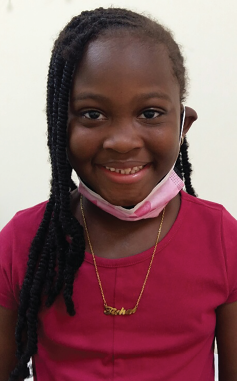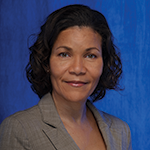
Featured on the booklet cover, Tishae Amya Evelyn was diagnosed with acute cutaneous lupus and alopecia in June 2020 at the age of 6.
The booklet includes information for rheumatologists in parts of the world where they don’t often treat Black patients and don’t have access to imagery that shows how lesions may differ in presentation on Black vs. white skin, as well as for primary care practitioners (PCPs), and covers case ascertainment, diagnosing lupus, principles in the management of lupus and life with lupus.
Although rheumatologists know the most common symptoms of SLE—painful, swollen joints, hair loss, rashes, mouth sores, fever and chest pain on deep breathing—the condition can mimic other diseases and may be tricky for specialists and PCPs alike to diagnose.
“Professor Nicholson’s mantra was always, ‘Young Black women of childbearing age with rheumatoid-like arthritis have lupus until proven otherwise,’” Dr. Flower says, adding that the best way to diagnose lupus is to simply to think of it and get familiar with the diverse ways in which it can present.
According to the publication, physicians considering a lupus diagnosis should be on the lookout for:
- A patient with any of the common symptoms, whether they occur concurrently or sequentially over time, and even with one resolving as another develops;
- A patient with an unexplained organ or system disorder, particularly if that patient is a young woman;
- A young (i.e., aged 15–40 years) patient with unprovoked thrombosis;
- A patient with proteinuria or impaired renal function, particularly a young (i.e., aged 15–40 years) female patient;
- A patient with a condition affecting more than one system of the body; and
- Any patient with an obscure diagnosis or presenting a diagnostic dilemma.
In Barbados, lupus is 14 times more common in women than men.3 So just being a woman is reason for the consideration of lupus in any of the above circumstances.
Delayed Diagnoses

Dr. Flower
The first three years of lupus are critical in terms of receiving treatment because serious complications, such as lupus nephritis and neuropsychiatric lupus, often occur during this time.4,5 According to Dr. Flower, patients with lupus who have had a delayed diagnosis tend to have had rashes that weren’t recognized as typical of lupus, joint pain that was attributed to minor random aches and pains, or proteinuria that was not expeditiously investigated.
“We want all doctors to consider the possibility of lupus in such cases,” Dr. Flower says. Based on her experience in clinical practice, she notes that young people of African origin, especially teenagers and persons in their early 20s who have developed proteinuria, are more likely to have SLE nephritis than renal complications of such diseases as hypertension and diabetes, which are easily ruled out.
Dr. Flower sees early treatment as so important that sometimes she treats a patient for SLE based on a good clinical diagnosis without waiting for results from serology tests, which in Barbados can sometimes take weeks to come back.
“In some parts of the world, a physician may be forced to treat with a presumptive diagnosis of lupus before having all the supportive data that bring reassurance. But that approach may be necessary to save a patient’s life,” she says.
Life & Lupus
Stress, pregnancy, parenting and poverty can all have a great impact on a patient diagnosed with lupus. Lupus Essentials balances current assessment and treatment options for lupus with these realities. “You can’t just manage the disease, you have to manage the patient,” Dr. Flower says.
Example: Dr. Flower discussed a young female patient she had with lupus nephritis. The patient, who wasn’t taking care of her health, showed up at the clinic with her toddler and said she thought she was having a nervous breakdown. The problem was, the patient couldn’t afford day care for her child, which distracted her from the management of her disease.
“She presented to my clinic with a social problem that needed to be addressed to allow her focus to return to managing her health,” Dr. Flower says. She referred her patient to a social worker and spoke with some nurses to find out how to help her patient find affordable day care.
“In a busy clinic, those tasks can feel burdensome, but they are all part of a physician’s duty to the patient.”
Renée Bacher is a health and medical writer based in Louisiana.
ACR Convergence 2021 Connection
This resource was discussed in the Nov. 3 session on Innovative Solutions to Global Challenges in Rheumatology. It’s not too late. Watch it on demand.
